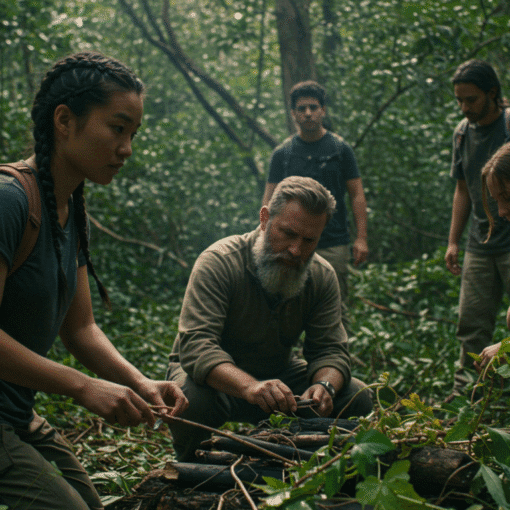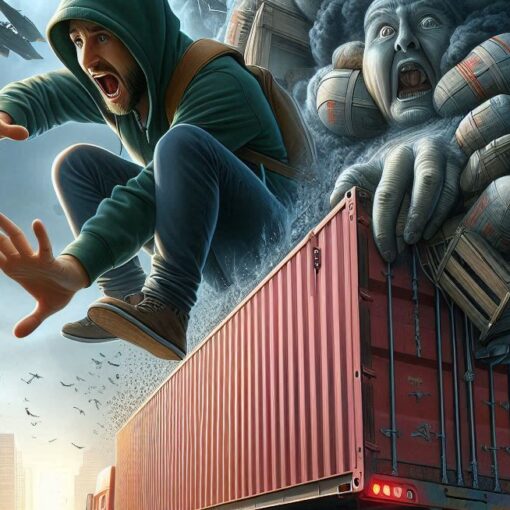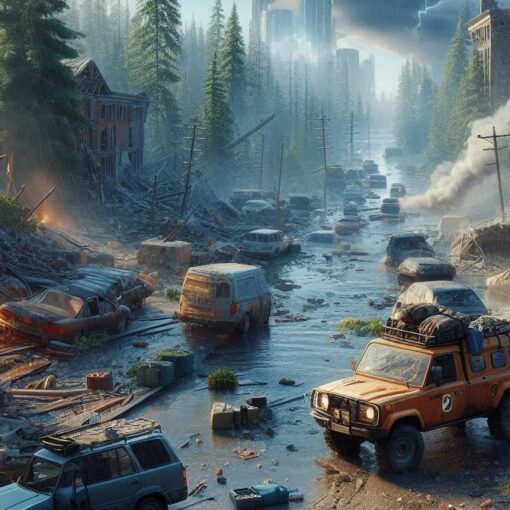Top Takeaways and Key Concepts
- Learn your neighborhood layout and identify hospitals, safe zones, and risky streets.
- Build a 72-hour emergency kit with water, food, first aid, tools, and light sources.
- Set up communication plans with family or friends, including backup meeting points.
- Stay informed with reliable news and emergency alert apps to avoid surprise crises.
- Know evacuation routes and practice them so you can leave quickly when necessary.
Summary of This Article
Please Note: This post may contain affiliate links. If you click one of them, we may receive a commission at no extra cost to you. As an Amazon Associate, I earn from qualifying purchases.
This article explains how to survive emergencies in an urban environment by staying prepared, aware, and organized. It stresses the importance of knowing your surroundings, such as local hospitals and danger zones, to make quick decisions during a crisis. Readers are encouraged to build an emergency kit with essentials like water, non-perishable food, first aid items, flashlights, and a multi-tool. Communication plans are vital, so group messages and meet-up points should be arranged in advance. Staying informed through alert apps and reliable news helps avoid dangerous surprises. Finally, the article emphasizes knowing when to evacuate and practicing escape routes to ensure safety when disaster strikes.
Video of This Article

Living in the city might feel like being on a never-ending episode of “Survivor,” but without the tropical beaches and cameras.
You need to be ready for everything that goes wrong, like a natural disaster, civil upheaval, or even your neighbor’s karaoke night going horrifically wrong. Here’s how to survive in the city with flair (and maybe even have some fun along the way).
Understanding Your Urban Jungle

First of all, cities are like rainforests, except instead of vines and wild animals, you have skyscrapers and stray cats that appear like they could kill an elephant. I think it’s important to know what’s around you, by the way. Get to know your surroundings so you can instantly spot safe areas and possible dangers.
Go on a walk around your neighborhood, but not around midnight when everything looks like a horror movie set. Do it during the day instead. Find out where the nearest hospitals are, which streets tend to flood (you don’t want to be paddling down Main Street), and where you can acquire food if things become bad.
It’s really important to know these things ahead of time; otherwise, you’ll be walking around asking for help while trying not to step on any gum that seems suspect.
It’s interesting that knowing this can also help you stay calm amid a real crisis. Picture yourself being calm as everyone else runs around screaming because they saw a raccoon going through trash cans. As you go toward safety, you’ll just smile to yourself.
Building Your Emergency Kit
Now let’s speak about putting together your emergency get-out bag, which will be your best friend when things go wrong. To be honest, every person who lives in a city should have one hidden away somewhere safe. And no, I’m not talking about those 2015 granola bars that taste more like cardboard than nourishment.
Here are some things you might want to think about adding:
1. Water: Enough bottled water to last you three days (or until your local shop opens again). Unless you want to be a human cactus, staying hydrated is really important.
2. Non-perishable food: Canned products or freeze-dried meals that won’t go bad faster than my desire to work out.
3. First Aid Supplies: Band-aids, antiseptics, and anything else that might be useful when someone gets harmed while trying to climb over fences during an evacuation.
4. Flashlights and batteries: It’s not a good idea to look for refuge in dark alleys with only the light from your phone.
5. A multi-tool or Swiss Army Knife: This small item will make you feel like MacGyver when all you wanted to do was open a drink!

If you take the time to acquire these things now, you’ll save yourself from running around later and asking if potato chips are non-perishable food.
Communication Is Key
When things are crazy, talking to each other is quite important. Just ask anyone who has tried to plan a family dinner over text! In an emergency, having reliable ways to stay in touch can make all the difference.
If you live close friends or family, you might want to set up group conversations so everyone knows what’s going on and whether or not there’s pizza!

If cell towers go down (which can happen during emergencies), you can use walkie-talkies or ham radios if you have them laying around from that “survivalist” period you went through after watching too many movies.
And on that note… It might also be a good idea to set up meeting places where everyone knows they can safely rejoin if communication breaks down completely. A specific café or park works great, as long as it doesn’t turn into another “lost dog” situation!
Staying Aware and Alert
When something bad happens in a city, like a flash flood or an unexpected demonstration, it’s important to keep attentive without becoming a nervous squirrel that runs back and forth across traffic lanes! But really? Being aware is very important; reading the news every day helps you not be caught off guard by things that happen out of the blue.
You don’t need CNN to play all the time (though I wouldn’t mind if it did!). Instead, look up information from trustworthy sources online, or better yet, download applications that send you warnings based on your location in real time. No one wants to be surprised when they’re already busy with life!
But it’s interesting because… Social media sites are also helpful for finding out what’s going on right outside your window!
Just keep in mind that not everything you see online is true. Always check the facts before you make a decision based on viral tweets with dancing llamas dressed as superheroes. Those are funny, though!
Know When to Evacuate
Finally, and this may sound simple, but please bear with me: recognize when it’s time to leave! Sometimes it feels safer to stay there than to dash into unknown terrain without knowing what’s going to happen (especially if there’s karaoke). But really? Ignoring warning signals might get you into trouble faster than forgetting where you parked downtown!
If officials tell you to leave because of things like storms getting closer or riots getting out of hand, you need to listen to them instead of arguing over whether “this will pass” over coffee at home.
Beforehand, make sure everyone knows the evacuation routes. Practice them every now and again so no one gets stranded behind Grandma driving 20 miles per hour on roads that are designated for quick escapes!
Frequently Asked Questions
What is urban survival and why is it important?
Urban survival is the ability to stay safe and prepared in a city during emergencies like natural disasters, power outages, riots, or infrastructure failures. Cities can become chaotic quickly, so having a plan and basic supplies can make the difference between panic and confidence.
What should I include in an urban emergency kit?
Your kit should have water, non-perishable food, a first aid kit, flashlight and batteries, a multi-tool, personal hygiene items, and important documents. Pack enough supplies to last at least 72 hours in case services are unavailable.
How do I prepare my family for a city emergency?
Discuss emergency plans with your family, choose safe meeting locations, and set up communication options like group texts or walkie-talkies. Practice evacuation routes regularly so everyone knows what to do and where to go under stress.
How can I stay informed during urban emergencies?
Use official news sources, emergency alert apps, and local government updates to stay aware. Social media can also help, but double-check all information to avoid falling for rumors or misinformation.
What are the biggest dangers to watch for in a city disaster?
Some common hazards include blocked roads, power outages, civil unrest, flash floods, contaminated water, and limited access to medical help. Staying alert and planning ahead reduces your risk dramatically.
When should I evacuate during a city emergency?
You should evacuate immediately when authorities issue an official evacuation order or if staying put becomes unsafe due to fire, flooding, gas leaks, or violence. Trust your instincts—if something feels dangerous, get out early.
What if cell service goes down and I can’t contact anyone?
Have backup communication options like walkie-talkies or a designated physical meetup location. Write down key phone numbers on paper in case your phone dies and plan ahead so everyone knows where to find each other without texting.
Suggested Resources:
Urban Survival Guide
https://www.survivalresources.com/urban-survival-guide
Emergency Preparedness Tips
https://www.ready.gov/emergency-preparedness-tips
The Ultimate Urban Survival Handbook
https://www.amazon.com/Ultimate-Urban-Survival-Handbook/dp/B00FQ9SQ8I

Kevin Collier is a seasoned outdoor enthusiast and writer for Trekbug.com, specializing in outdoor adventures, survival strategies, and prepping insights. With a deep love for nature and a commitment to self-sufficiency, Kevin empowers readers to embrace the wilderness confidently. He shares valuable tips, practical techniques, and inspiring stories, helping both novice and experienced adventurers develop essential skills for surviving and thriving in the great outdoors.





